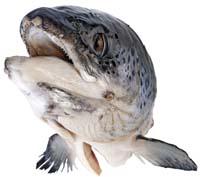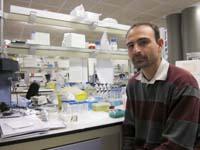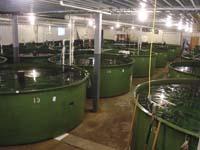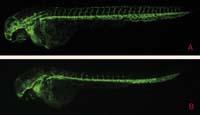Transgenic salmon against the current

AquAdvantage is the most likely transgenic fish to be the first to hit the market. Developed by the US company AquaBounty, it claims that its growth is twice as fast as the common salmon: GM takes 30 months to take the marketing measure of common farm salmon (5.8 kilos), while GM takes between 15 and 18 months.
This growth is due to a transgene, transgenic salmon is Atlantic salmon, but Chino has included in its genome the salmon growth hormone gene. This gene encodes the same protein, but is otherwise regulated, allowing fish to grow and reach faster.
AquaBounty highlights that the fish they have developed does not contain proteins other than salmon. Therefore, there are no causes of allergy or risk to the health of consumers. It has the same flavor and nutritional composition as the common salmon. In any case, AquaBounty has stated that the difference can be in quality, since its nurseries can be easily placed anywhere, placing them close to consumers would greatly reduce the distance and transport time. This would mean the possibility of marketing salmon in an optimal way.
On the other hand, AquaBounty has taken drastic measures to avoid the environmental effects of a breeding stock of transgenic fish, especially to prevent leakage. In fact, according to studies on this subject, the animals with the highest risk of leakage are insects and fish. And there are many examples of escaped Atlantic salmon and their damage. For example, when farm salmon cross with savages, the next generation is often weak and with survival problems. Salmon escaped to the Pacific compete with native salmon species.
Trojans and sterile females
Regarding the consequences of escapes, researchers at Purdue University have presented the "Trojan gene hypothesis". According to them, few Aquadvantage salmon can make the wild salmon population disappear from a certain area. AquaBounty, however, responds that the mathematical model designed by researchers to reach this result is not based on their salmon, but on the Japanese transgenic medaca. This fish reaches adulthood in 56 days and reproduces daily until its death. Salmon, on the other hand, takes 3-5 years to reach adulthood -- even about 10 years -- and often only reproduces once throughout life.

Nevertheless, AquaBounty only produces sterile females. To do this, shortly after fertilization apply a high pressure on the eggs, avoiding the loss of a group of chromosomes that is normally lost, resulting in triploid, sterile fish. In addition, nurseries are very safe, but if some specimens escape they would not be able to cross and reproduce, neither among them nor with wild salmon. In addition, in nature they would not live, because they are not used to looking for food and facing difficulties.
Provisional to final
AquaBounty has therefore confirmed that it has taken all possible measures from the sanitary and environmental point of view and is ready to be marketed. To do this, you must obtain local authorization and, in the United States, the responsible is the FDA, the official body responsible for the safety of medicines and food.
Late last summer the FDA released its AquAdvantage salmon safety reports. According to the speakers, the composition of this transgenic salmon is the same as that of common salmon, so it has no harmful health effects. However, the FDA says more testing needs to be done to ensure there is no risk of allergies.
The FDA has also considered transgenic salmon safe in its environmental report. He literally concludes: "In short, in order to totally avoid environmental risk, various and redundant simultaneous measures will be implemented in the production and growth of AquAdvantage salmon." Therefore, you have concluded that you have ensured that it is safe for the environment.

However, the results and conclusions of the reports were insufficient to obtain definitive marketing authorization. In fact, after the publication of the reports, it is the turn of the expert debate. There were two debates in which some biologists and ecologists who participated in the debate said more evidence had to be done.
They say it has happened with some drugs that have not been seen to be harmful until they have been put on the market, and they fear that the same can happen with transgenic fish. In addition, it was questioned that the efficacy of the sterilization method is 100%. However, some experts proposed a solution: give marketing authorization, but explain on a label that it is a genetically modified product.
This measure, however, goes against FDA principles, which refuses to label according to the mode of production. The rules indicate that only “material differences” (texture, composition, etc.) which can generate the production method should appear on the label, not by the method itself. And for AquAdvantage salmon, the FDA has found no difference between this salmon and the common salmon.
Finally, the FDA agreed to do more studies, so AquaBounty salmon has no marketing authorization at the moment.
Technological progress

Although, according to some, the FDA's decision has been satisfactory, companies working on the marketing of transgenic fish have been desperate. In particular, AquaBounty is developing another species, applying the same technology, fast-growing trout.
There are also projects outside the United States. For example, the Institute of Hydrobiology of the Chinese Academy of Sciences has been willing to market a rapidly growing transgenic tent, but its managers do not give them permission. Similar situation in Cuba. There they have genetically transformed tilapia to grow faster than normal, and in other countries there are fish projects that have been transformed to be resistant to diseases. They are all waiting for the final FDA decision that will affect them.
The situation is different in Europe. In fact, the only authorized transgenic fish are those for research. With them works the Donostian company Biobide. According to Carles Callol, scientific director of Biobide, "it is wonderful that gene transfer technology has developed to that extent." The social acceptance of transgenic fish for consumption is considered a challenge.
However, according to Callol, the growth of transgenic fish is an opportunity to reduce the suffering of animals and also to protect the ecosystem, since it must be taken into account, for example, that along with the fish that want to fish when fishing, other species of other species are caught in nets. "In addition," said Callolek-- "this allows more people to get the calories and protein they need. Of course, we have to be firmly convinced that it will be safe for people and the environment and that it will not provoke a monopoly."
Specifically, Callol believes that in granting marketing authorization this aspect should be taken into account. "The criteria of the FDA and those responsible for the European Union are very strict in terms of health and environmental safety, but patent companies should also monitor their behaviour on the market. Otherwise, there is a risk of monopolies."

However, from a scientific point of view, the scientific director of Biobide states that it is a "milestone": "It seems tremendous to me that a project started at the level of specimens ends up being applicable and reaches the market and, in addition, benefits people. It also seems very important to me as a conceptual test. That is, it is wonderful to know that this technology can be used, controlled, characterized and reproduced. Possible transfer to other species. Imagine what it would be like to do here, for example with anchovy."
But to get to this you have to follow many steps. And it seems that the first can be given in the United States, authorizing the marketing of AquAdvantage salmon. To see when it will be.






